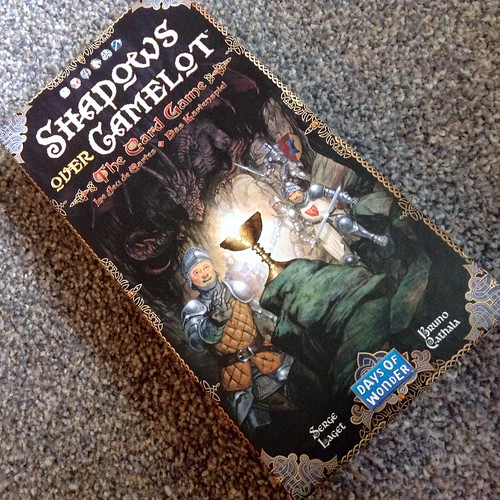
Shadows over Camelot, in its original boardgame form, is recognised as a classic of the genre of cooperative game with hidden traitors. I’ve never actually played it, as I also own Battlestar Galactica: the Boardgame which follows a very similar path (and is very enjoyable).
However, I love the Arthurian setting, and have long enjoyed it as a gaming setting with the Pendragon RPG. Admittedly, I always went for the more Roman flavour of the Mary Stewart Merlin series, rather than full on Mallory, but I love the mythic, historic, tragic feel. So when a quick to play card game variant of Shadows over Camelot came out, I was quick to snap it up.
The game is produced by Days of Wonder, and has very good quality production values. It is a card game, but has a number of counters used to represent quests that Merlin has decided to intervene in, and swords (double-sided, black and white to represent success and who it aligns with).
The core game comes with a Quest deck (split into a variety of threats/quests facing Camelot such as Picts, Saxons, Dragons, The Holy Grail, and finding Excaliber), a deck of Knights, and a loyalty deck.
The Loyalty deck is used to determine whether or not there is a traitor present. Traitors win if 7 or more black swords are accumulated, whereas normal, loyal, Knights win if 7 or more white swords are gained. It is possible that there is no traitor or even two traitors if you have a higher number of players.
The Quests are rated in Swords that you will gain when they are resolved. If you are successful, you gain white swords, else they are black, traitorous, blades.
Each player draws a card from the Quest deck on their turn. The card is placed on top of the other cards drawn so far so they can’t be seen, as the core mechanic involves your memory of the cards that have been played. Most cards are Quest cards - they have one of the Quests shown, and a number from 1 to 5 or a ‘?’ variable number. So, as cards accumulate for each quest in the played deck, the sum of the difficult of each gets higher. The players need to cooperate and use their memories to decide when to try and resolve the quests and which one to do.
This cooperation could make things simple if it wasn’t for the character cards in the Quest deck. Merlin appears, and his effect tends to be to reduce the threat level of each quest. Mordred appears, and he will strengthen the Picts and Saxons. Vivian appears, and she can cause a shift in loyalties. And then, there is Morgan. Morgan is the big bad. When you draw her card, the players may no longer talk to each other until a Merlin card is drawn again. Morgan will also either modify the final scoring or change the ways the quests work, normally to the detriment of the loyal players. These impacts include the quest cards being played face down so you can lie what you have drawn through to changes in the strengths of each quest itself.
Success in a Quest is a finely balanced thing. To succeed, you need to resolve the quest when the total points sum to 10, 11, 12 or 13. Any higher, and you have left it so late and it hurts the kingdom. Any lower, and you have responded with force too earlier and it hurts the kingdom. Failure gives black swords, success white. So a traitor will be trying to steer towards black swords…
Another complication is the variable cards. They score the same number of points as there are variable cards in that quest. So a single card scores 1 x 1 point and three cards would score 3 x 3 points. If you lose count, it is very easy to underestimate the impact of these.
Resolution is simple. You pick a quest as the primary one, then sort the cards out. The Morgan cards affect the results as they indicate. The Merlin cards typically remove the highest card in a pre-selected quest. Mordred boosts the Saxons and Picts. You then check the score. You also resolve the other quests - the secondary quests. All you want to happen here is to make sure that they each sum to thirteen or less, else you gain the black swords from them as the threat was ignored while you dealt with the primary Quest.
The game is really quite simple, and quick to play, so you could get several games in an hour.
I had a chance to play this (albeit a brief one) at Continuum, which I enjoyed thoroughly despite it being after 1am in the morning. The interaction with the different players definitely worked well and made the game more fulfilling than the solo variant. There is also an advanced version of the game where characters such as Arthur can intervene. However, I’ve not tried that yet as I wanted to get the basics firmly understood first. I’ll update this when I try it.
No comments:
Post a Comment